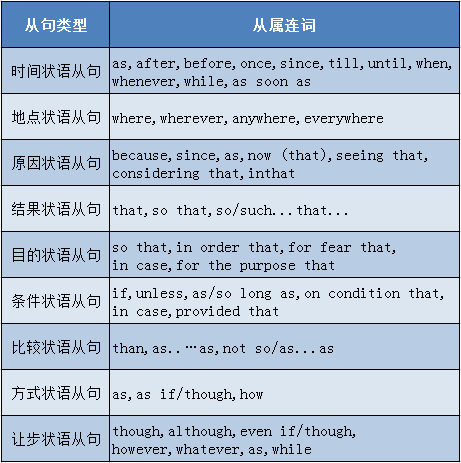在复合句中,修饰主句或主句谓语的句子叫作状语从句。状语从句可位于主句之前,也可位于主句之后。状语从句可分为时间、地点、原因、结果、条件、方式、让步、比较和目的等九大类。

⒈ 上述有些连词除了能引导状语从句外,还可引导定语从句和名词性从句。在使用的时候,要根据句子结构和句意来判别和区分不同的从句,正确使用引导词。以where为例,试比较下列多种从句的区别。
如:You are to find it where you left it.(地点状语从句)
Tell me the address where he lives.(定语从句,先行词为the address)
I don't know where he came from.(宾语从句)
Where he has gone is not known yet.(主语从句)
This place is where they once hid.(表语从句)
⒉ 在两个分句间要有一个且只有一个连词,千万不能按汉语习惯。
如:Because he was ill,he didn't come to school.
=He was ill,so he didn't come to school.
⒊ 在时间、地点、条件、方式或让步状语从句中,若从句的主语与主句的主语一致(或从句的主语为it),从句的谓语又包含动词be时,从句中的“主语+be”部分可省略。
如:When (he was)asked about it,he kept silent.
Fill in the blanks with articles when (they are)necessary.
If(it is)possible,I'll explain it again later.
She stood at the gate as if (she was) waiting for someone.
⒈ when引导的时间状语从句
① when引导的时间状语从句,其动词既可以是延续性动作的动词,也可以是瞬间性动作的动词,可以表示主句的动作和从句的动作同时发生,或从句的动作发生在主句的动作之前。
如:When you apply for a job,you must present your credentials.当你申请工作时,你必须递交你的有关证件。(同时)
When the students heard the teacher's footsteps,they sopted talking.当学生们听到老师的脚步声时,他们都停止了讲话。(从句动作发生在前)
② when 还可表示just then(正在那时)的意思,此时其所引导的从句只放在主句之后。
如:We were about to start when it began to rain.我们正要动身,突然天下起雨来。
The game had hardly/scarcely/barely begun when it started raining.比赛刚刚开始就下起雨来。
⒉ as引导的时间状语从句
as 侧重表示主句和从句的动作并相发生,翻译成“一边……一边……”。
如:We were having breakfast as she was combing her hair.她梳头时我们在吃早饭。
⒊ while引导的时间状语从句
while或“在……期间”,所引导的从句的动作是延续性的,并表示和主句的动作同时发生。
如:When the teacher paraphrased the text in English,the students listened attentively and took notes.当老师用英语解释课文时,学生们聚精会神地听并做着笔记。
I can learn while I work.我可以边工作边学习。
⒋ before引导的时间状语从句
① before“在……之前”
如:I'll be back before you have left.你离开之前我就会回来。
② before“……之后才”
如:It may be many years before we meet again.可能要过许多年我们才能再见了。
It was three days before I came back.他三天后才回来。
⒌ as soon as/once/directly/the instant引导的时间状语从句
as soon as是最常见的表示“一……就”的从属连词,其他连词还有immediately,instantly,the instant(that),the minute(that),the moment(that)等,它们通常都可与as soon as换用。
如:As soon as we got home,the telephone rang.我们一到家,电话就响了。
I recognized her immediately I saw her.我一看见她就认出她来了。
Directly the teacher came in everyone was quiet.老师一进来,大家就静了下来。
⒍ hardly…when/no sooner…than引导的时间状语从句
关联从属连词hardly/barely/scarcely…when 和 no sooner..than的意思是“刚……就”,它们所引导的从句中的谓语动词通常为过去完成时。
如:He had no sooner (no sooner had he)arrived home than he was asked to start on another journey.他刚一到家,就又要他出另一次差。
No sooner had the words been spoken than he realized that he should have remained silent.这些话刚一出口,他就意识到自己应该保持沉默。
⒎ since引导的时间状语从句
在含有since引导的时间状语从句的复合句中,从句的谓语动词通常为一般过去时,主句的谓语动词通常为现在完成时、过去完成时和一般现在时。
如:We've never met since we graduated from the college.大学毕业后我们就再没见过面。
Great changes have taken place since you left.你走了以后,这里发生了巨大变化。
⒏ till/until引导的时间状语从句till和until同义,作“直到……时(为止)”解,till多口语话,until多用于句首。
如:Donald will remain in college until(till)he finishes his Ph.D course.唐纳德将留在学校直到完成他的博士学位课程。
I won't go with you until(tll)I finished my homework.等我做完作业我才和你一起去。
⒈ where引导的地点状语从句,从属连词where“在(或到)……的地方”
如:Where there is a will,there is a way.有志者事竟成。
Put it where you found it.把它放在原来的地方。
where 在地点状语从句中,除指地点外,还可指处境等。
如:He said he was happy where he was.他说他对自己的处境很满意。
It's your fault that she is where she is.她今天落到这个地步都怪你。
⒉ wherever引导的地点状语从句wherever=no matter where后者只能放句首。从属连词wherever“在(或到)……的各个地方”
如:You can go wherever(anywhere)you like these day.这些天你可以去你想去的地方。
Where(no matter where)they went the experts were warmly welcomed.专家每到一处,都受到热烈的欢迎。
Sit down wherever you like.你喜欢坐哪儿就坐哪儿(wherever 不可以换成no matter where)
⒈ because引导的原因状语从句
通常用于回答why引出的疑问句,语气最强,该从句一般位于主句后面。
如:I didn't go abrord with her because I couldn't afford it.我没有和她一起出国是因为费用太高。
Don't scamp your work because you are pressed for time.不要因为时间仓促而马马虎虎。
⒉ as引导的原因状语从句
as 引导的原因状语从句多位于主句之前,通常可以和since换用。
如:As I didn't know the way, l asked a policeman.我不认识路,因而问警察。
As it is snowing we shall not climb the mountain.由于在下雪,我们不去爬山了。
⒊ since引导的原因状语从句
since 引导的原因状语从句多位于主句之前,通常可以和as换用。与as用法一样
如:Since traveling by air is much faster,they decided to take a plane.既然乘飞机旅行快得多,他们就决定坐飞机。
Since you won't help me,I'll ask someone else.你既然不帮我,那我就请别人帮忙。
⒋ now(that)引导的原因状语从句,now(that)“既然”
如:Now(that) you have passed your test you can drive on your own.你既已考试合格,就可以独自开车了。
⒌ seeing(that)引导的原因状语从句
Seeing(that)“鉴于;由于”,通常用于非正式文体。
如:Seeing(that) the weather is bad, we'll stay at home.天气不好,我们还是呆在家里吧。
⒈so tha引导的结果状语从句
① so that引导的结果状语从句只能位于主句之后,so that引导什么从句根据句意来判断
如:Suddenly it began to rain heaily, so that it was almost impossible to carry on driving.突然下起了大雨,几乎无法继续开车。
Linda phoned me in on arrival so that I know she was safe and sound.琳达到达后给我打了电话,因而我知道她平安无事。
② so…that引导的结果状语从句
so…that“如此……以致”,that 可以省略,so后面接形容词或副词。
如:She spoke so fast that nobody could catch what she was saying.她说话如此之快竟没有人听出来她在讲什么。
There is so little time left that I have to tell you about it latter.现在剩下的时间不多了,我只好以后再给你讲这件事。
③ such…that引导的结果状语从句
引导结果状语从句的such…that的具体内容是:such+a/an+形容词+名词+that从句;such+a/an+形容词+单数名词+that=so+形容词+a/an+单数名词+that从句。
如:The professor told us such a funny story that all the students laughed.
(=The professor told us so funny a story that all the students laughed.)教授讲了个很有趣的故事,(以致于)所有的学生都笑了起来。
⒈ in order that导的目的状语从句
in order that 为了;以便”。多用于正式文体,通常可以与so that换用。
如:they stopped at Hangzhou in order that they could go around West Lake.他们在杭州停了下来,以便游览西湖。
The expert spoke slowly in order that everyone should understand.专家讲得很慢,以便人人听得懂。
⒉ so (that)导的目的状语从句
so that“为了;以便”。so that通常可以与in order that换用,它所引导的目的状语从句总是放在主句之后,在非正式文体中,常省略that。
如:Speak clearly so that they may understand you.你要讲得清楚,他们才听得懂。
She wanted tea ready at seven so she could be out by eight.她要七点钟备好茶点,这样她八点以前就可以出门了。
⒊ in case/for fear(that)引导的目的状语从句
in case for fear(that)这俩个从属连词都表示否定目的,意思是“以免”,“以防”。in case它所引导的从句中的谓语动词可以是陈述语气形式,也可以是虚拟语气形式;for fear(that)引导的从句中的谓语带有may,might,should 等情态动词。
如:Take your umbrella in case it rains.带上你的伞,以防下雨。
He took an umbrella with him for fear that it might rain.他带了一把伞,以防下雨。
⒈ if引导的条件状语从句,翻译成“如果”
如:If I were a bird,l would fly.如果他说了那样的话,他不可能是说实话。
⒉ unless引导的条件状语从句
unless 引导的是否定条件状语从句,在意义上相当于if..not,而且语气较强,一般不用于虚拟语气。
如:You'll be late unless you hurry.你会迟到的,如果不赶快的话。
⒊ if only引导的条件状语从句
ifonly在引导条件状语从句时意为“只要;如果”。
如:I'll let you use the car if only you keep it in good condition.只要你把车保养好,我就让你用。
⒋ as/so long as引导的条件状语从句,as/so long as意为“只要;如果”。
如:As long as it doesn't rain,we can play.只要不下雨我们就能玩。
⒌ provided(that)/providing(that)引导的条件状语从句,provided(that)/providing(that)意为“如果;只要”。
如:I will aree to go providing(that my expense are paid.)假如为我负担费用,我就同意去。
⒈ as…as引导的比较状语从句
as…as 表示同级比较,主句中用形容词或副词的原级形式,从句常常为省略句。
如:We were as fortunate as them(they were).我们和他们一样幸运。
I hope she will make as much progress as you (have done). 我希望她将取得和你同样的进步。
⒉ not so/as..as引导的比较状语从句
not so/as..as表示同级比较,主句中用形容词或副词的原级形式,从句常常为省略句。如:That's not so/as simple as it sounds.那件事情不像听起来那么简单。
⒈ as引导的方式状语从句
as 在引导方式状语从句时意为“以……方式;如同……那样”,从句有时是省略句。
如:Do as I say.要照我说的做。
I did just as you told me.我正是照你说的办的。
Air is to man as water is to fish.空气之于人犹如水之于鱼。
⒉ as if/as thougl导的方式状语从句
as if和as though的用法相同,都作“好像,仿佛”;二者引导的状语从句往往用虚拟语气,表示与事实相反。
如:They looked at me as if/as though I were mad.他们瞧着我好像我发疯了似的。
They look as if/as though they know each other.他们看来好像互相认识。
⒈ although/though引导的让步状语从句
although和though,都作“虽然;尽管”,通常可以换用.
如:Although they have been talking, for a long time,he can not make her believe him.虽然和她谈了半天,他还是不能让她信任自己。
⒉ even if引导的让步状语从句
even if“即使,纵然”,从句表示的是尚未发生的动作或存在的情况。
如:Even if I failed again,I will not give up the experiment.即使我再次失败,我也决不会放弃实验。
⒊ even though导的让步状语从句
even though“虽然,尽管”,通常可以和although/though换用。
如:Even though I didn't understand a work, I kept smiling.即使我一个字也不懂,我还是保持微笑。
Even though you say so l do not believe it.即使你这样说,我也不信。
⒋ while引导的让步状语从句,while“虽然,尽管”
如:While I understand your point of view, I do not share it.我虽了解你的观点,但不敢苟同。
⒌ whatever/no matter what引导的让步状语从句
Whatever=no matter what都作“无论什么”
如:Whatever/No matter what he says,don't go.不管他说什么,你都不要走。
We are determined to fulfill the task whatever/no matter what happens.不管发生什么了,我们决心完成任务。
⒍ whichever/no matter which引导的让步状语从句
Whichever=no matter which都作“无论哪个”
如:Whichever/No matter which you buy, there is a six-month guarantee.
不论你买哪个,都有六个月的保修期。
Whichever/No matter which of the two men had stolen her purse, Barbara was determined to find them.不管这两个人是谁偷了她的钱包,芭芭拉决心找到他们。
⒎ whoever/no matter who 引导的让步状语从句
Whoever=no matter who都作“无论谁”
如:You can't come in, whoever you are.不管你是谁,都不能进来。
⒏ however/no matter how 引导的让步状语从句
However=no matter how都作“无论如何……”
如:However high it maybe it can't reach the sky.它不论有多高,也高不到天上去。
⒐ whenever/no matter when引导的让步状语从句
Whenever=no matter when都作“无论何时”
如:Whenever I'm unhappy,he cheers me up.每当我不高兴时,他就给我鼓劲儿。
⒑ as引导的让步状语从句
as 在引导让步状语从句时作“虽然;尽管”和“即使”解,但是它不位于句首,在它前面的可以是形容词、名词、副词等。
如:Strong as you maybe,you cannot lift it.虽然你可能很有力气,你却无法把它提起来。
Late as it was,they continued to study.时间尽管不早了,他们仍继续学习。










